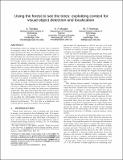Using the Forest to See the Trees: Exploiting Context for Visual Object Detection and Localization
Author(s)
Torralba, Antonio; Murphy, K. P.; Freeman, William T.
DownloadFreeman-Using the forest.pdf (1.013Mb)
OPEN_ACCESS_POLICY
Open Access Policy
Creative Commons Attribution-Noncommercial-Share Alike
Terms of use
Metadata
Show full item recordAbstract
Recognizing objects in images is an active area of research in computer vision. In the last two decades, there has been much progress and there are already object recognition systems operating in commercial products. However, most of the algorithms for detecting objects perform an exhaustive search across all locations and scales in the image comparing local image regions with an object model. That approach ignores the semantic structure of scenes and tries to solve the recognition problem by brute force. In the real world, objects tend to covary with other objects, providing a rich collection of contextual associations. These contextual associations can be used to reduce the search space by looking only in places in which the object is expected to be; this also increases performance, by rejecting patterns that look like the target but appear in unlikely places.
Most modeling attempts so far have defined the context of an object in terms of other previously recognized objects. The drawback of this approach is that inferring the context becomes as difficult as detecting each object. An alternative view of context relies on using the entire scene information holistically. This approach is algorithmically attractive since it dispenses with the need for a prior step of individual object recognition. In this paper, we use a probabilistic framework for encoding the relationships between context and object properties and we show how an integrated system provides improved performance. We view this as a significant step toward general purpose machine vision systems.
Date issued
2010-03Department
Massachusetts Institute of Technology. Department of Electrical Engineering and Computer ScienceJournal
Communications of the ACM
Publisher
Association for Computing Machinery (ACM)
Citation
A. Torralba, K. P. Murphy, and W. T. Freeman. 2010. Using the forest to see the trees: exploiting context for visual object detection and localization. Communications of the ACM 53, 3 (March 2010), 107-114.
Version: Author's final manuscript
ISSN
0001-0782